Abstract
Galactose-grown cells of the heterofermentative lactic acid bacteria Lactobacillus brevis and Lactobacillus buchneri transported methyl-beta-D-thiogalactopyranoside (TMG) by an active transport mechanism and accumulated intracellular free TMG when provided with an exogenous source of energy, such as arginine. The intracellular concentration of TMG resultant under these conditions was approximately 20-fold higher than that in the medium. In contrast, the provision of energy by metabolism of glucose, gluconate, or glucosamine promoted a rapid but transient uptake of TMG followed by efflux that established a low cellular concentration of the galactoside, i.e., only two- to fourfold higher than that in the medium. Furthermore, the addition of glucose to cells preloaded with TMG in the presence of arginine elicited a rapid efflux of the intracellular galactoside. The extent of cellular TMG displacement and the duration of the transient effect of glucose on TMG transport were related to the initial concentration of glucose in the medium. Exhaustion of glucose from the medium restored uptake and accumulation of TMG, providing arginine was available for ATP generation. The nonmetabolizable sugar 2-deoxyglucose elicited efflux of TMG from preloaded cells of L. buchneri but not from those of L. brevis. Phosphorylation of this glucose analog was catalyzed by cell extracts of L. buchneri but not by those of L. brevis. Iodoacetate, at a concentration that inhibits growth and ATP production from glucose, did not prevent efflux of cellular TMG elicited by glucose. The results suggested that a phosphorylated metabolite(s) at or above the level of glyceraldehyde-3-phosphate was required to evoke displacement of intracellular TMG from the cells. Counterflow experiments suggested that glucose converted the active uptake of TMG in L. brevis to a facilitated diffusion mechanism that allowed equilibrium of TMG between the extra- and intracellular milieux. The means by which glucose metabolites elicited this vectorial regulation is not known, but similarities to the inducer expulsion that has been described for homofermentative Streptococcus and Lactobacillus species suggested the involvement of HPr, a protein that functions as a phosphocarrier protein in the phosphotransferase system, as well as a presumptive regulator of sugar transport. Indeed, complementation assays wit extracts of Staphylococcus aureus ptsH mutant revealed the presence of HPr in L. brevis, although this lactobacillus lacked a functional phaosphoenolpyruvate-dependent phosphortransferase system for glucose, 2-deoxyglucose, or TMG.
Full text
PDF
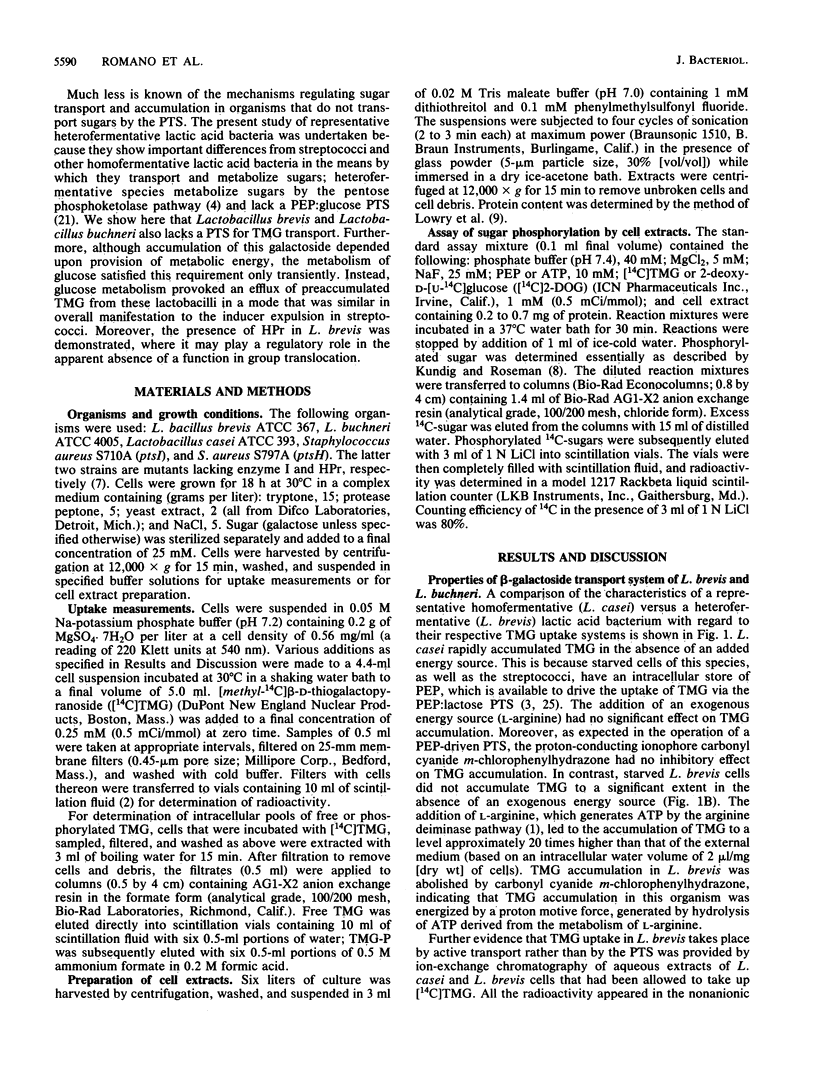
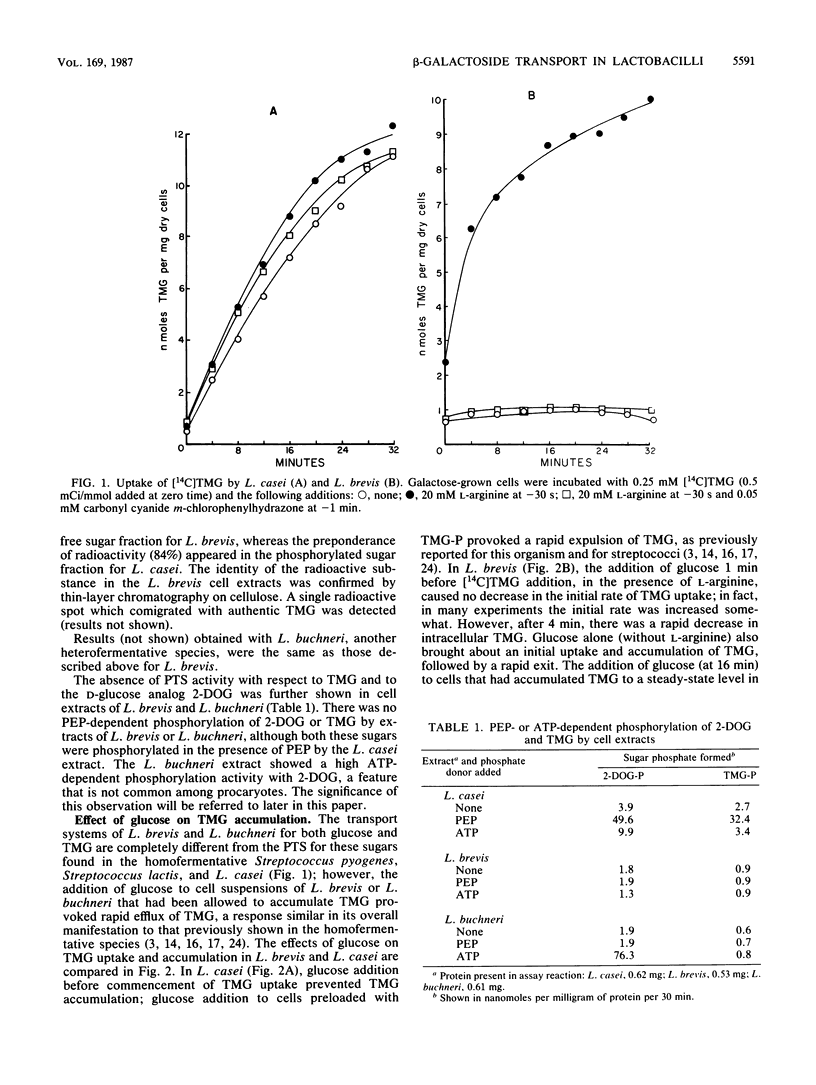
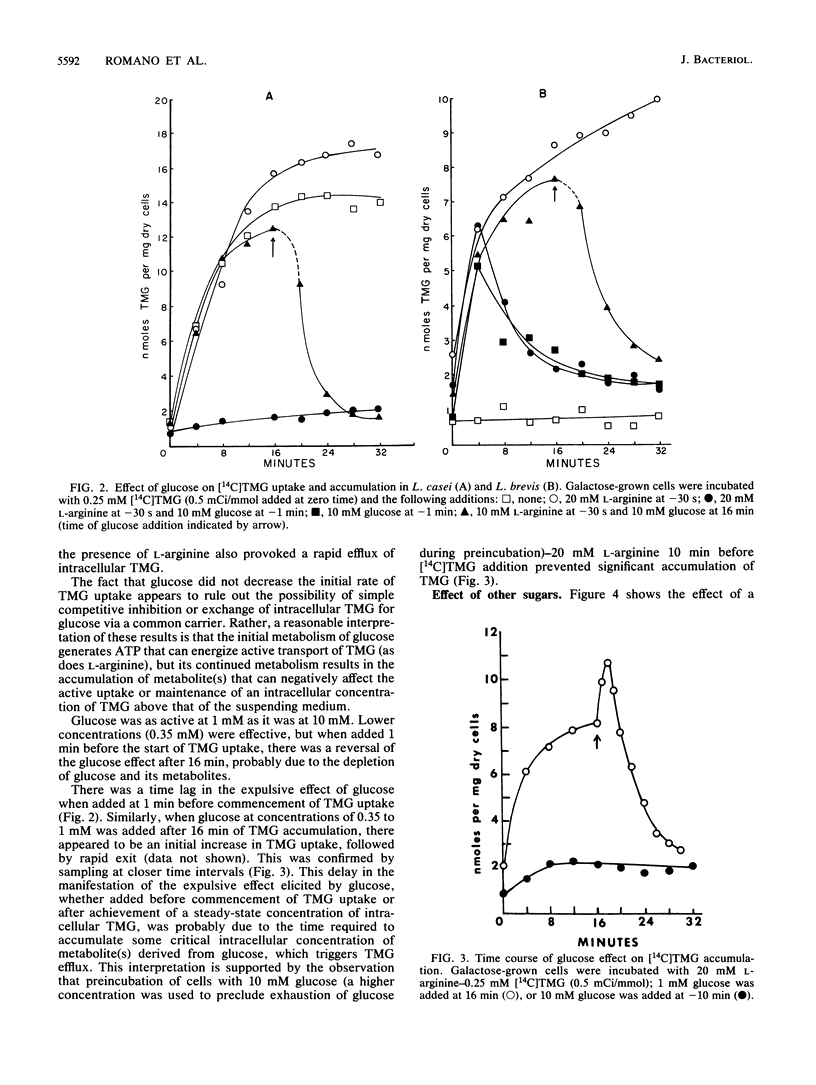
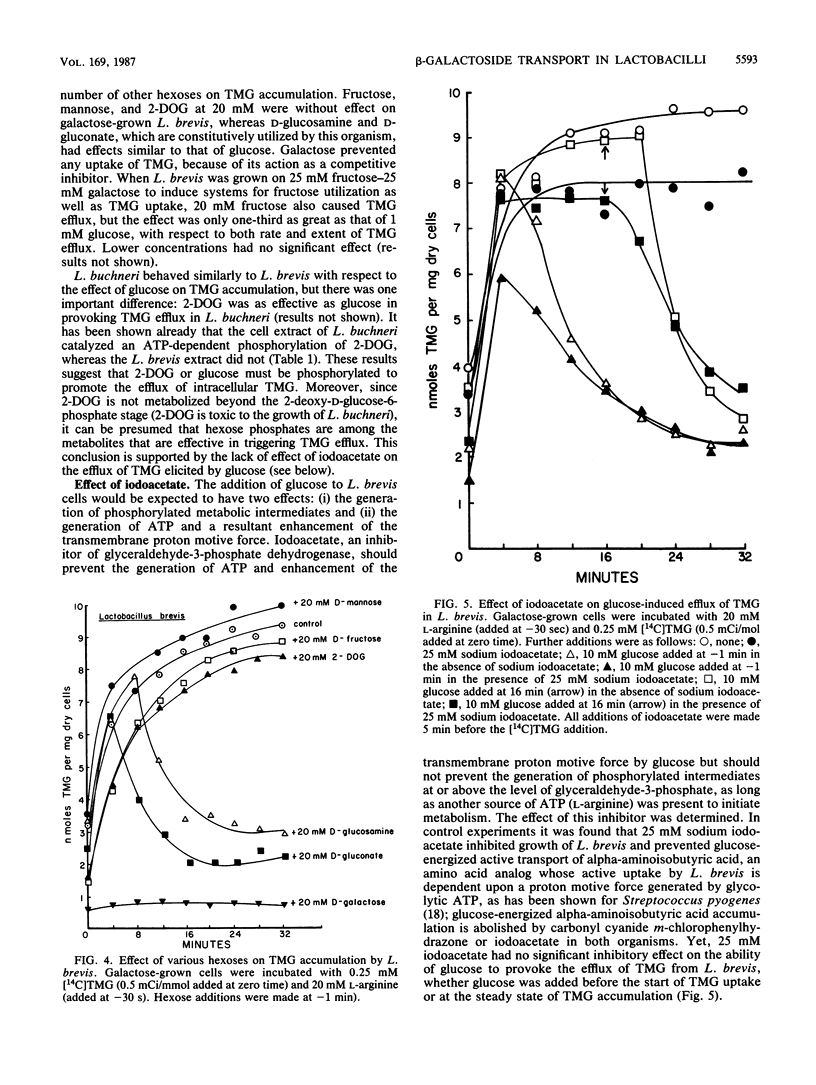

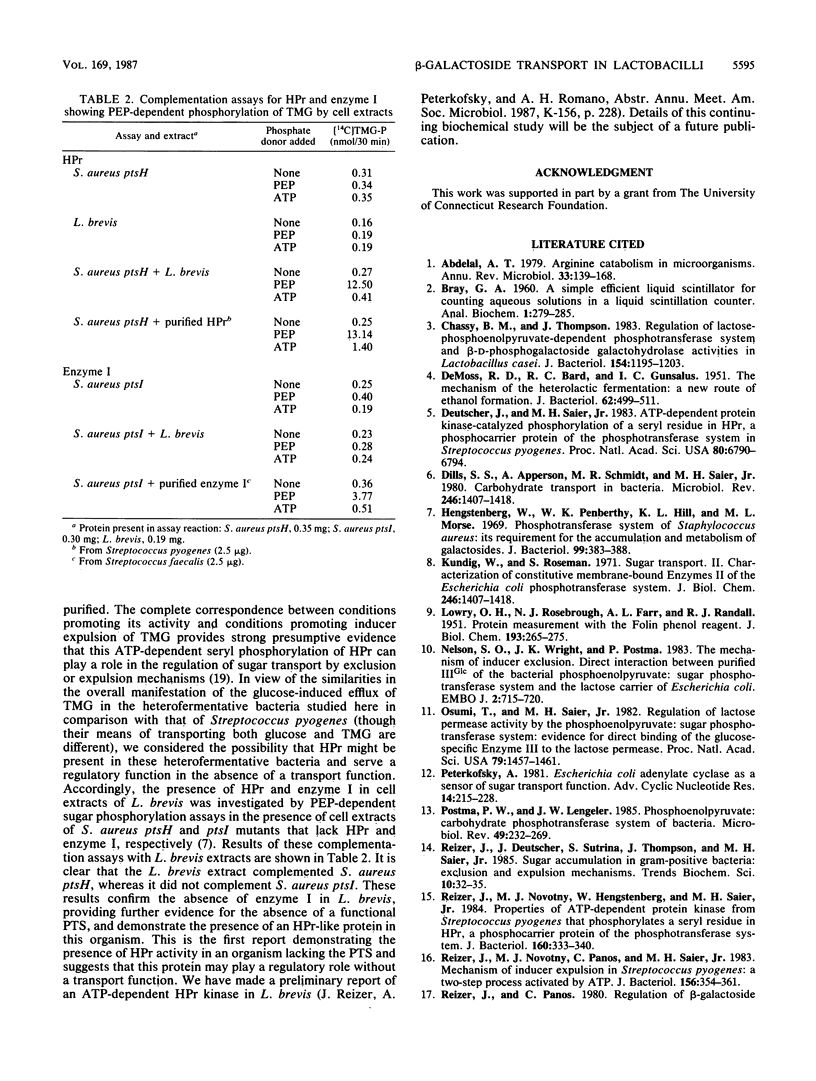

Selected References
These references are in PubMed. This may not be the complete list of references from this article.
- Abdelal A. T. Arginine catabolism by microorganisms. Annu Rev Microbiol. 1979;33:139–168. doi: 10.1146/annurev.mi.33.100179.001035. [DOI] [PubMed] [Google Scholar]
- Chassy B. M., Thompson J. Regulation of lactose-phosphoenolpyruvate-dependent phosphotransferase system and beta-D-phosphogalactoside galactohydrolase activities in Lactobacillus casei. J Bacteriol. 1983 Jun;154(3):1195–1203. doi: 10.1128/jb.154.3.1195-1203.1983. [DOI] [PMC free article] [PubMed] [Google Scholar]
- DeMOSS R. D., BARD R. C., GUNSALUS I. C. The mechanism of the heterolactic fermentation; a new route of ethanol formation. J Bacteriol. 1951 Oct;62(4):499–511. doi: 10.1128/jb.62.4.499-511.1951. [DOI] [PMC free article] [PubMed] [Google Scholar]
- Deutscher J., Saier M. H., Jr ATP-dependent protein kinase-catalyzed phosphorylation of a seryl residue in HPr, a phosphate carrier protein of the phosphotransferase system in Streptococcus pyogenes. Proc Natl Acad Sci U S A. 1983 Nov;80(22):6790–6794. doi: 10.1073/pnas.80.22.6790. [DOI] [PMC free article] [PubMed] [Google Scholar]
- Hengstenberg W., Penberthy W. K., Hill K. L., Morse M. L. Phosphotransferase system of Staphylococcus aureus: its requirement for the accumulation and metabolism of galactosides. J Bacteriol. 1969 Aug;99(2):383–388. doi: 10.1128/jb.99.2.383-388.1969. [DOI] [PMC free article] [PubMed] [Google Scholar]
- Kundig W., Roseman S. Sugar transport. II. Characterization of constitutive membrane-bound enzymes II of the Escherichia coli phosphotransferase system. J Biol Chem. 1971 Mar 10;246(5):1407–1418. [PubMed] [Google Scholar]
- LOWRY O. H., ROSEBROUGH N. J., FARR A. L., RANDALL R. J. Protein measurement with the Folin phenol reagent. J Biol Chem. 1951 Nov;193(1):265–275. [PubMed] [Google Scholar]
- Nelson S. O., Wright J. K., Postma P. W. The mechanism of inducer exclusion. Direct interaction between purified III of the phosphoenolpyruvate:sugar phosphotransferase system and the lactose carrier of Escherichia coli. EMBO J. 1983;2(5):715–720. doi: 10.1002/j.1460-2075.1983.tb01490.x. [DOI] [PMC free article] [PubMed] [Google Scholar]
- Osumi T., Saier M. H., Jr Regulation of lactose permease activity by the phosphoenolpyruvate:sugar phosphotransferase system: evidence for direct binding of the glucose-specific enzyme III to the lactose permease. Proc Natl Acad Sci U S A. 1982 Mar;79(5):1457–1461. doi: 10.1073/pnas.79.5.1457. [DOI] [PMC free article] [PubMed] [Google Scholar]
- Peterkofsky A. Escherichia coli adenylate cyclase as a sensor of sugar transport function. Adv Cyclic Nucleotide Res. 1981;14:215–228. [PubMed] [Google Scholar]
- Postma P. W., Lengeler J. W. Phosphoenolpyruvate:carbohydrate phosphotransferase system of bacteria. Microbiol Rev. 1985 Sep;49(3):232–269. doi: 10.1128/mr.49.3.232-269.1985. [DOI] [PMC free article] [PubMed] [Google Scholar]
- Reizer J., Novotny M. J., Hengstenberg W., Saier M. H., Jr Properties of ATP-dependent protein kinase from Streptococcus pyogenes that phosphorylates a seryl residue in HPr, a phosphocarrier protein of the phosphotransferase system. J Bacteriol. 1984 Oct;160(1):333–340. doi: 10.1128/jb.160.1.333-340.1984. [DOI] [PMC free article] [PubMed] [Google Scholar]
- Reizer J., Novotny M. J., Panos C., Saier M. H., Jr Mechanism of inducer expulsion in Streptococcus pyogenes: a two-step process activated by ATP. J Bacteriol. 1983 Oct;156(1):354–361. doi: 10.1128/jb.156.1.354-361.1983. [DOI] [PMC free article] [PubMed] [Google Scholar]
- Reizer J., Panos C. Transport of alpha-aminoisobutyric acid by Streptococcus pyogenes and its derived L-form. J Bacteriol. 1982 Jan;149(1):211–220. doi: 10.1128/jb.149.1.211-220.1982. [DOI] [PMC free article] [PubMed] [Google Scholar]
- Reizer J., Saier M. H., Jr Involvement of lactose enzyme II of the phosphotransferase system in rapid expulsion of free galactosides from Streptococcus pyogenes. J Bacteriol. 1983 Oct;156(1):236–242. doi: 10.1128/jb.156.1.236-242.1983. [DOI] [PMC free article] [PubMed] [Google Scholar]
- Romano A. H., Trifone J. D., Brustolon M. Distribution of the phosphoenolpyruvate:glucose phosphotransferase system in fermentative bacteria. J Bacteriol. 1979 Jul;139(1):93–97. doi: 10.1128/jb.139.1.93-97.1979. [DOI] [PMC free article] [PubMed] [Google Scholar]
- Thompson J., Saier M. H., Jr Regulation of methyl-beta-d-thiogalactopyranoside-6-phosphate accumulation in Streptococcus lactis by exclusion and expulsion mechanisms. J Bacteriol. 1981 Jun;146(3):885–894. doi: 10.1128/jb.146.3.885-894.1981. [DOI] [PMC free article] [PubMed] [Google Scholar]
- Thompson J., Thomas T. D. Phosphoenolpyruvate and 2-phosphoglycerate: endogenous energy source(s) for sugar accumulation by starved cells of Streptococcus lactis. J Bacteriol. 1977 May;130(2):583–595. doi: 10.1128/jb.130.2.583-595.1977. [DOI] [PMC free article] [PubMed] [Google Scholar]


